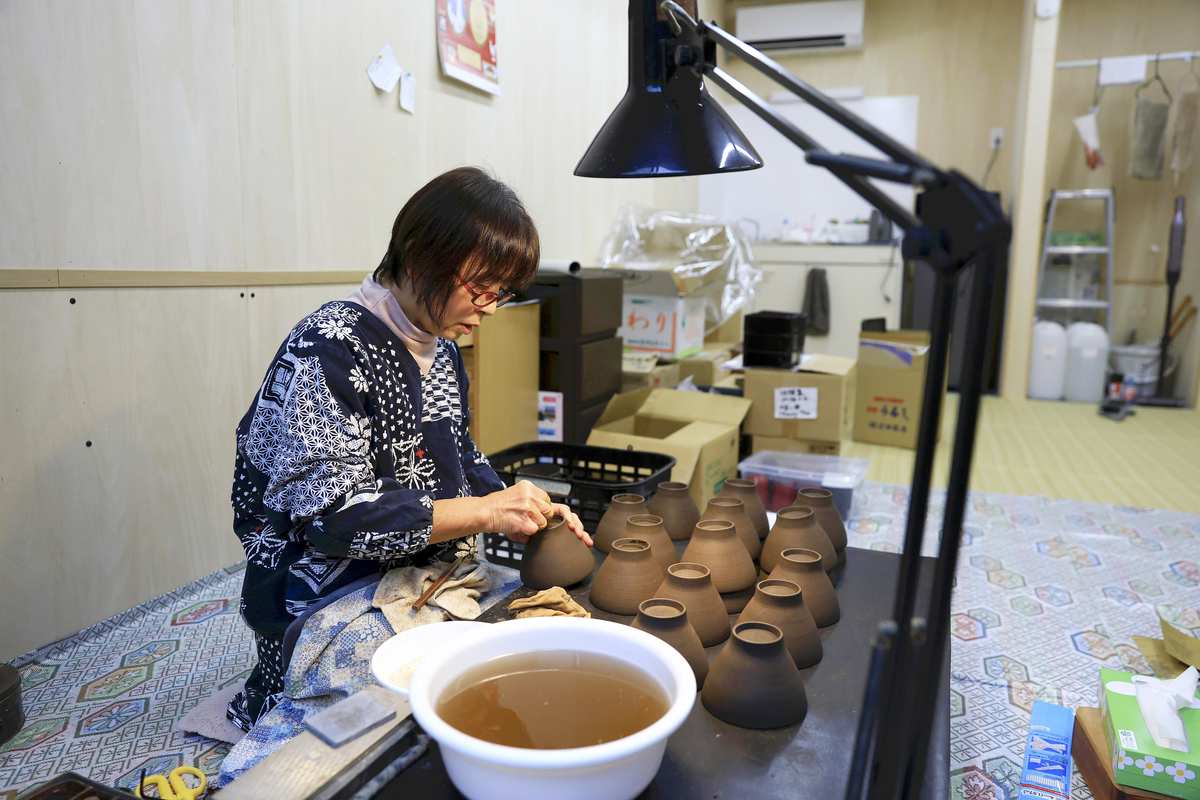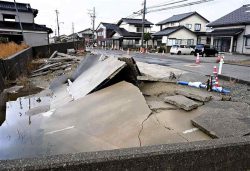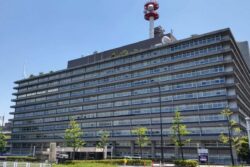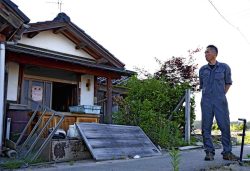Wajima’s Lacquerware Industry Struggles toward Revival, Despite Ravages of Nature and Market

Polisher Naoko Yachi works on Wajima-nuri lacquerware at a temporary workshop in Wajima, Ishikawa Prefecture, in December.
17:31 JST, January 9, 2025
The wheels are turning on efforts to support the Wajima-nuri lacquerware industry, but the future of this traditional craft remains uncertain one year on from the Noto Peninsula Earthquake.
Many artisans involved in Wajima-nuri production were directly affected by the earthquake that devastated the Wajima region in Ishikawa Prefecture on Jan. 1, 2024. Besides rebuilding from the earthquake, the industry also must grapple with challenges that predate the disaster, such as the ageing of its skilled craftspeople, a shortage of successors to carry on Wajima-nuri techniques, and a growing tendency of households to eschew lacquerware. Traditional festivals and events in the region are also at risk of extinction. The central and local governments are working to revive an industry and cultural events that have held a special place in people’s hearts.
In a 30-square-meter temporary workshop the Wajima municipal government established on city-owned land, polisher Naoko Yachi spins an already-made teacup on a wood turner and then uses a whetstone to apply an additional touch. Yachi’s own home and workshop were destroyed by the earthquake. In February, she applied for a temporary workshop, and moved into the facility in November. For eight hours each day, she polishes pieces of the local lacquerware, which has been designated a national important intangible cultural property.
“I’m grateful that this workshop was built so quickly,” Yachi said.
According to the Wajima Lacquerware Industry and Commerce Cooperative Association, the earthquake damaged or destroyed workshops and stores of more than half of the association’s 103 members, and 17 members had their buildings razed by the fire that engulfed the Wajima Morning Market after the shaking. Many artisans who worked at these businesses had no choice but to evacuate after the disaster, leaving the production of Wajima-nuri lacquerware, which requires many hands to produce, at risk of disappearing.
Concerned by this situation, the Wajima city government in March started constructing temporary workshops with subsidies from the central government. Record-breaking torrential rain that lashed Wajima in September flooded seven of these workshops above floor level, but a total of 83 workshops had been constructed on eight city-owned plots by the end of 2024. Tenants are permitted to use the workshops for 2½ years.
“The expectation is that the artisans won’t stay in these temporary facilities permanently,” an official from the city’s lacquerware commerce and industry division said. “We hope they’ll rebuild their own workshops during this time.”
Wajima-nuri, regarded as one of Japan’s signature varieties of lacquerware, has a production process that includes over 120 steps, which are divided among specialized craftspeople. Made from local diatomaceous earth mixed with lacquer, each piece is coated multiple times and can feature decorations in gold or silver powder that are either painted on or made through carving. Wajima-nuri is known for its durability and elegance.
Value just one-seventh of peak
However, the Wajima-nuri industry had been struggling to overcome daunting challenges even before the earthquake struck.
According to the city government, the value of Wajima-nuri produced in the region peaked at ¥18 billion in 1991, but had dropped to ¥2.4 billion in 2023.
A decline in high-volume orders from restaurants and ryokan inns, and sluggish demand due to lifestyle changes such as the growing popularity of Western tableware, have contributed to the collapse in the market. At a time when cheap, sturdy dishes are widely available, the high cost of Wajima-nuri has also turned many consumers away.
About 700 people worked in Wajima-nuri-related jobs, including sales positions, in 2023, which was about one-quarter of the craft’s workforce at its peak. About 70% of these workers were age 60 or older.
About 20% of the Wajima-nuri workers who left the city after the earthquake have yet to return. Eight Wajima-nuri businesses affiliated with the Wajima Chamber of Commerce and Industry have reportedly closed down or plan to shut their doors. There are mounting fears that this local industry could shrink even further.
“If the deep-rooted techniques in this region and the close connections among people involved in Wajima-nuri whither away, the entire Noto Peninsula could slip into a downward spiral as its vitality is drained,” said University of Toyama Associate Prof. Yukiharu Yasujima, an expert on traditional industries.
Seeking markets abroad
In March, the government launched a cross-departmental team, centered on the Cultural Affairs Agency, that is tasked with preserving Wajima-nuri techniques. The government issued subsidies worth more than ¥55 million for such purposes as replacing tools at the quake-hit Ishikawa Prefectural Wajima Institute of Lacquer Arts and setting up mobile homes in which trainees can stay. The Economy, Trade and Industry Ministry decided to offer subsidies worth ¥458 million such as for the purchase of tools and materials by quake-affected businesses in traditional craft industries.
To bolster the ranks of young artisans, the Ishikawa prefectural government aims to establish a training institute in Wajima as soon as fiscal 2027. Each year, about five trainees age 40 or younger will be accepted to the institute to spend two years learning the techniques necessary to carry on the traditional craft. These trainees also will be taught how to tap into overseas markets and develop new Western-style tableware, stationery and other products that are suited to modern-day lifestyles. Details including the facility’s scale and the curriculum will be fleshed out from fiscal 2025, which starts in April. Haruhiko Daiku, head of a Wajima lacquerware youth association, has high hopes the new institute will help the industry recover.
“Increasing the number of young people in the industry is just the starting point,” said Daiku, 37. “We need to convey the charm of this craft and create an environment in which people from other fields can easily get involved and become artisans.”
Festivals face stark future
Some festivals dating back many years also are at risk of vanishing.
Kiriko festivals, in which locals parade large lantern floats called kiriko, are held in across the Noto Peninsula in summer and autumn. The season-opening festival, held in the town of Noto, was celebrated last year as usual, but many other festivals have been scaled back or canceled due to damaged roads and a lack of people to carry them on. Kiriko were rolled out at 182 locations in six cities and towns in the Noto region in 2018, but this figure plunged to just 30 locations in 2024, the year the quake hit.
Similar difficulties have plagued the Aenokoto agricultural ritual, which was registered as Intangible Cultural Heritage by UNESCO in 2009. During this ritual, an agricultural deity is invited into the house and food is served to express gratitude for the harvest. In the town of Noto, 73-year-old Masamichi Naka had publicly conducted the ritual in the old house. However, Naka canceled last year’s event because the earthquake damaged the house’s internal walls.
“It’s a pity that we’ve lost this chance to share this local tradition,” Naka said.
"Society" POPULAR ARTICLE
-

M4.9 Earthquake Hits Tokyo, Neighboring Prefectures
-

Israeli Tourists Refused Accommodation at Hotel in Japan’s Nagano Pref., Prompting Protest by Israeli Embassy and Probe by Prefecture
-

M7.5 Earthquake Hits Northern Japan; Tsunami Waves Observed in Hokkaido, Aomori and Iwate Prefectures
-

Tsukiji Market Urges Tourists to Avoid Visiting in Year-End
-

High School in Kyoto Says Students Shoplifted during Recent School Trip to Bali, Indonesia
JN ACCESS RANKING
-

Tokyo Economic Security Forum to Hold Inaugural Meeting Amid Tense Global Environment
-

Keidanren Chairman Yoshinobu Tsutsui Visits Kashiwazaki-Kariwa Nuclear Power Plant; Inspects New Emergency Safety System
-

Imports of Rare Earths from China Facing Delays, May Be Caused by Deterioration of Japan-China Relations
-

University of Tokyo Professor Discusses Japanese Economic Security in Interview Ahead of Forum
-

Japan Pulls out of Vietnam Nuclear Project, Complicating Hanoi’s Power Plans

























